-
 Bitcoin
Bitcoin $105,953.9980
3.06% -
 Ethereum
Ethereum $2,445.3292
6.68% -
 Tether USDt
Tether USDt $1.0006
-0.03% -
 XRP
XRP $2.1968
7.03% -
 BNB
BNB $643.2903
2.13% -
 Solana
Solana $144.2799
3.82% -
 USDC
USDC $1.0000
-0.03% -
 TRON
TRON $0.2739
0.49% -
 Dogecoin
Dogecoin $0.1642
4.47% -
 Cardano
Cardano $0.5834
5.49% -
 Hyperliquid
Hyperliquid $38.0741
2.80% -
 Sui
Sui $2.7741
7.56% -
 Chainlink
Chainlink $13.4107
11.26% -
 Bitcoin Cash
Bitcoin Cash $450.4828
-0.61% -
 UNUS SED LEO
UNUS SED LEO $9.1301
0.64% -
 Stellar
Stellar $0.2476
5.49% -
 Avalanche
Avalanche $18.0637
5.09% -
 Toncoin
Toncoin $2.9066
2.43% -
 Shiba Inu
Shiba Inu $0.0...01160
4.01% -
 Hedera
Hedera $0.1527
8.00% -
 Litecoin
Litecoin $84.6122
2.37% -
 Monero
Monero $317.6076
5.76% -
 Ethena USDe
Ethena USDe $1.0008
0.02% -
 Polkadot
Polkadot $3.4519
5.27% -
 Dai
Dai $1.0000
-0.03% -
 Bitget Token
Bitget Token $4.2835
5.62% -
 Uniswap
Uniswap $7.0443
9.78% -
 Pepe
Pepe $0.0...09964
7.41% -
 Pi
Pi $0.5391
4.64% -
 Aave
Aave $264.1743
11.26%
How to judge when the moving average system is in a short position but the KDJ is oversold?
When the moving average signals a short position and the KDJ is oversold, traders face a conflict: bearish momentum vs. potential exhaustion, requiring confirmation from price action, volume, and multiple timeframes to avoid false signals.
Jun 24, 2025 at 10:22 pm
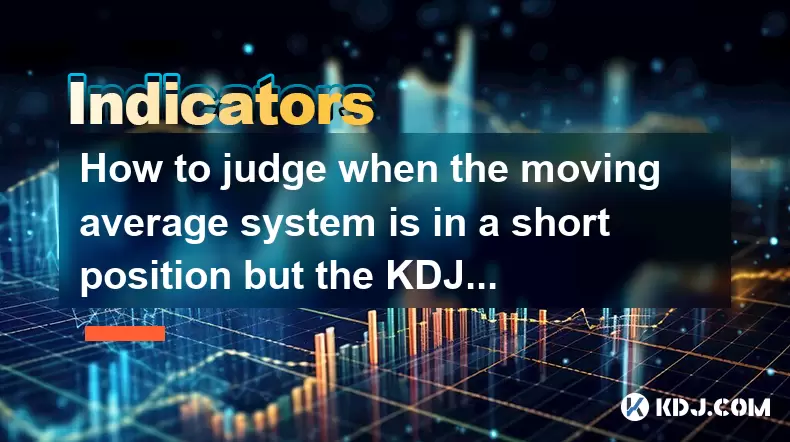
Understanding the Moving Average System in Short Position Context
In cryptocurrency trading, a moving average (MA) system is commonly used to identify trends. When the MA system indicates a short position, it typically means that the price has crossed below key moving averages such as the 50-day or 200-day MA. This signals a potential downtrend and traders may consider entering short trades.
Short position indication from the MA system can be confirmed by observing multiple timeframes. For instance, if both the 15-minute and 1-hour charts show prices consistently below the moving averages, this strengthens the bearish signal. It's crucial to assess the slope of the moving averages as well; a steep downward slope suggests strong selling pressure.
Key Tip:
Always look for confluence between different moving averages and timeframes before confirming a short bias.Deciphering KDJ Indicator Oversold Conditions
The KDJ indicator, also known as the stochastic oscillator, helps traders determine overbought and oversold conditions. In an oversold state, the KDJ lines (especially %K and %D) fall below a threshold — usually 20 — indicating that the asset might be undervalued and due for a bounce.
However, in crypto markets, especially during strong downtrends, the KDJ can remain oversold for extended periods. This means that just because the indicator shows oversold doesn’t necessarily mean a reversal is imminent. Traders should avoid relying solely on the KDJ for entry signals without additional confirmation.
Important Note:
Oversold readings during a strong bear trend may lead to false signals if not analyzed within broader market context.Combining Moving Averages with KDJ Signals
When the moving average system signals a short position while the KDJ is oversold, it presents a conflicting scenario. On one hand, the MA suggests continued bearish momentum; on the other, the KDJ hints at exhaustion in the downtrend.
- Analyze divergence: Look for bullish divergence on the KDJ where price makes a new low but the KDJ does not. This could indicate weakening momentum.
- Cross-check with volume: If volume starts to decline during the downtrend, it may suggest waning interest from sellers.
- Timeframe alignment: Ensure consistency across multiple timeframes. For example, a short-term oversold condition on the 1-hour chart may not override a long-term bearish setup on the daily chart.
Caution:
Never assume a reversal just because the KDJ is oversold. Wait for price action confirmation.Practical Steps to Evaluate the Scenario
To judge whether to act on this situation, follow these steps:
- Identify key moving averages (e.g., 50 EMA and 200 SMA) and check if price is consistently below them.
- Check the KDJ settings — default is often 9,3,3, but some traders adjust it based on volatility.
- Look for crossovers in the KDJ: a %K crossing above %D in oversold territory might suggest a short-term reversal.
- Observe candlestick patterns like hammer or engulfing candles near major support levels for added confirmation.
- Use risk management tools like stop-loss orders to protect against sudden reversals even when indicators seem aligned.
Strategy Insight:
Combine technical indicators with price action analysis to filter out false signals and enhance decision-making accuracy.Recognizing Market Context and Sentiment
Market sentiment plays a critical role in how technical indicators behave. During high volatility or negative news cycles in crypto, the KDJ may give premature oversold signals while the moving averages continue to trend downward.
- Monitor macro events: News about regulation, exchange hacks, or global economic shifts can impact crypto prices significantly.
- Assess social media and community sentiment: Tools like Google Trends or Twitter sentiment analysis can provide insights into retail trader psychology.
- Watch for whale movements: Large transactions on-chain can distort price action and affect indicator reliability.
Critical Reminder:
Technical indicators work best when aligned with prevailing market conditions and not in isolation.Frequently Asked Questions
Q: Can I use the RSI instead of KDJ in this scenario?
A: Yes, RSI is another momentum oscillator that can be used alongside moving averages. However, each indicator has its own sensitivity and parameters. While RSI tends to be smoother, KDJ reacts faster to price changes, which can be both an advantage and a drawback depending on the market environment.
Q: Should I ignore KDJ completely if the moving averages are strongly bearish?
A: No, you shouldn't ignore it entirely. Instead, treat it as a secondary tool. In a strong downtrend, the KDJ may offer short-term pullback opportunities rather than full reversals.
Q: How do I set stop losses effectively in this mixed signal environment?
A: Set stop losses slightly beyond recent swing highs or key resistance levels. Also, consider using a percentage-based stop or a volatility-adjusted stop (like ATR) to avoid being stopped out prematurely.
Q: Is this strategy applicable to all cryptocurrencies?
A: The principles apply broadly, but execution may vary. High-cap coins like Bitcoin and Ethereum tend to have more reliable technical setups compared to smaller altcoins, which can be more erratic and less predictable.
Disclaimer:info@kdj.com
The information provided is not trading advice. kdj.com does not assume any responsibility for any investments made based on the information provided in this article. Cryptocurrencies are highly volatile and it is highly recommended that you invest with caution after thorough research!
If you believe that the content used on this website infringes your copyright, please contact us immediately (info@kdj.com) and we will delete it promptly.
- Stablecoins, Blockchain Games, and NxtNexus: A Deep Dive
- 2025-06-25 10:25:13
- Children: Yesterday, Today, and Tomorrow's Promise
- 2025-06-25 10:45:13
- £1 Coin: Valuable Finds and Expert Tips for Collectors
- 2025-06-25 11:05:13
- £1 Coin, Mistake, Worth £500: Are You Sitting on a Goldmine?
- 2025-06-25 11:25:12
- Spot the Mistake: Is Your £1 Coin Worth £500?
- 2025-06-25 11:45:13
- XRP, Ripple, Legal Saga: Navigating Uncertainty with Stablecoin Strategies
- 2025-06-25 10:52:16
Related knowledge
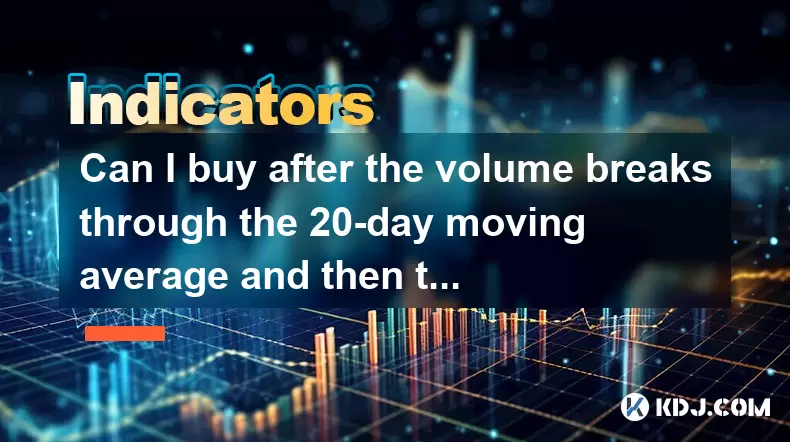
Can I buy after the volume breaks through the 20-day moving average and then the volume shrinks and then the callback is pulled back?
Jun 25,2025 at 12:00pm
Understanding Volume and Moving Averages in Cryptocurrency TradingIn the world of cryptocurrency trading, volume and moving averages are two critical indicators that traders rely on to make informed decisions. The 20-day moving average (MA) is a popular tool used to identify trends and potential entry or exit points. When volume breaks through this aver...
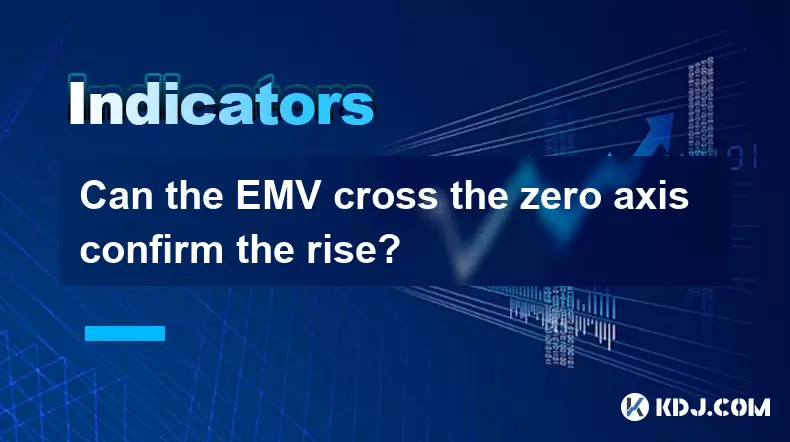
Can the EMV cross the zero axis confirm the rise?
Jun 25,2025 at 11:14am
Understanding the EMV Indicator in Cryptocurrency TradingThe Ease of Movement Value (EMV) is a technical analysis indicator commonly used by traders to assess the relationship between price and volume. In the cryptocurrency market, where volatility is high and trends can reverse quickly, understanding how to interpret EMV becomes crucial for making info...
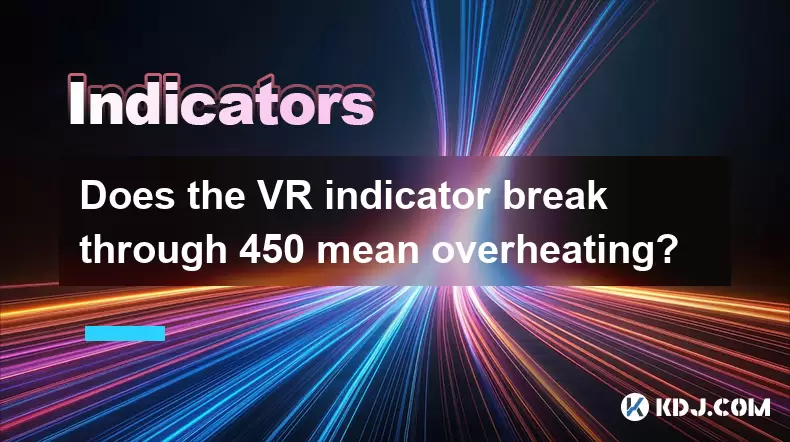
Does the VR indicator break through 450 mean overheating?
Jun 25,2025 at 10:15am
Understanding the VR Indicator in Cryptocurrency AnalysisThe VR indicator, or Volume Ratio, is a technical analysis tool used to assess buying and selling pressure by comparing the volume of up days to down days over a specified period. In cryptocurrency trading, where volatility is high and sentiment shifts rapidly, the VR indicator helps traders ident...

Should we exit the market when the TSI indicator forms a head and shoulders top pattern in the overbought zone?
Jun 25,2025 at 10:50am
Understanding the TSI Indicator and Its Relevance in Cryptocurrency TradingThe True Strength Index (TSI) is a momentum oscillator commonly used by traders to identify overbought or oversold conditions in financial markets, including cryptocurrencies. It is calculated using double smoothing of price changes, which helps filter out noise and provides more...
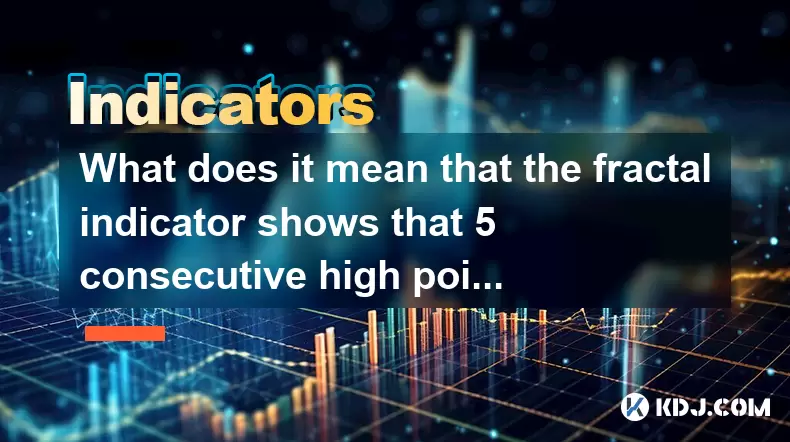
What does it mean that the fractal indicator shows that 5 consecutive high points are gradually rising?
Jun 25,2025 at 11:07am
Understanding the Fractal Indicator in Cryptocurrency TradingThe fractal indicator is a popular technical analysis tool used by traders in the cryptocurrency market to identify potential reversal points in price action. It is based on a mathematical concept known as fractals, which are repeating patterns that occur across different time frames. In tradi...
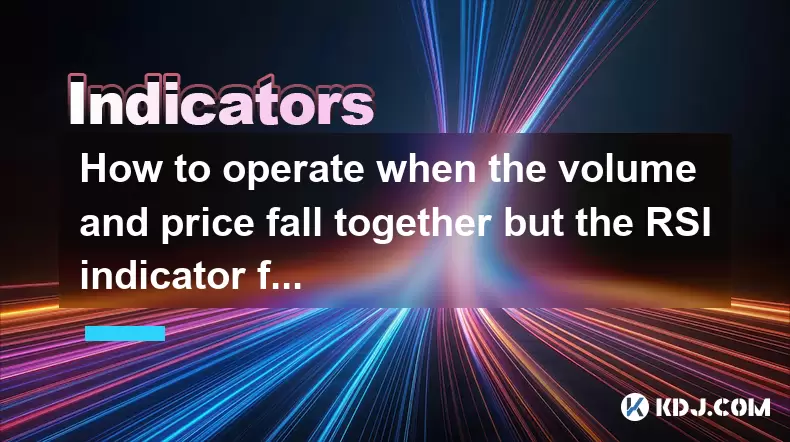
How to operate when the volume and price fall together but the RSI indicator forms a bottom divergence?
Jun 25,2025 at 04:29am
Understanding the Concept of RSI Bottom DivergenceWhen analyzing cryptocurrency price charts, traders often rely on technical indicators to spot potential reversals. One such signal is a bottom divergence in the Relative Strength Index (RSI). This occurs when the price makes a new low, but the RSI does not confirm that low and instead forms a higher low...

Can I buy after the volume breaks through the 20-day moving average and then the volume shrinks and then the callback is pulled back?
Jun 25,2025 at 12:00pm
Understanding Volume and Moving Averages in Cryptocurrency TradingIn the world of cryptocurrency trading, volume and moving averages are two critical indicators that traders rely on to make informed decisions. The 20-day moving average (MA) is a popular tool used to identify trends and potential entry or exit points. When volume breaks through this aver...

Can the EMV cross the zero axis confirm the rise?
Jun 25,2025 at 11:14am
Understanding the EMV Indicator in Cryptocurrency TradingThe Ease of Movement Value (EMV) is a technical analysis indicator commonly used by traders to assess the relationship between price and volume. In the cryptocurrency market, where volatility is high and trends can reverse quickly, understanding how to interpret EMV becomes crucial for making info...

Does the VR indicator break through 450 mean overheating?
Jun 25,2025 at 10:15am
Understanding the VR Indicator in Cryptocurrency AnalysisThe VR indicator, or Volume Ratio, is a technical analysis tool used to assess buying and selling pressure by comparing the volume of up days to down days over a specified period. In cryptocurrency trading, where volatility is high and sentiment shifts rapidly, the VR indicator helps traders ident...

Should we exit the market when the TSI indicator forms a head and shoulders top pattern in the overbought zone?
Jun 25,2025 at 10:50am
Understanding the TSI Indicator and Its Relevance in Cryptocurrency TradingThe True Strength Index (TSI) is a momentum oscillator commonly used by traders to identify overbought or oversold conditions in financial markets, including cryptocurrencies. It is calculated using double smoothing of price changes, which helps filter out noise and provides more...

What does it mean that the fractal indicator shows that 5 consecutive high points are gradually rising?
Jun 25,2025 at 11:07am
Understanding the Fractal Indicator in Cryptocurrency TradingThe fractal indicator is a popular technical analysis tool used by traders in the cryptocurrency market to identify potential reversal points in price action. It is based on a mathematical concept known as fractals, which are repeating patterns that occur across different time frames. In tradi...

How to operate when the volume and price fall together but the RSI indicator forms a bottom divergence?
Jun 25,2025 at 04:29am
Understanding the Concept of RSI Bottom DivergenceWhen analyzing cryptocurrency price charts, traders often rely on technical indicators to spot potential reversals. One such signal is a bottom divergence in the Relative Strength Index (RSI). This occurs when the price makes a new low, but the RSI does not confirm that low and instead forms a higher low...
See all articles
























































































